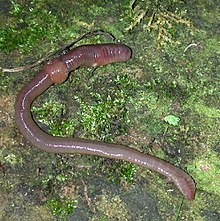| Lumbricidae | |
|---|---|

| |
| Lumbricus terrestris, the common European earthworm | |
| Scientific classification | |
| Domain: | Eukaryota |
| Kingdom: | Animalia |
| Phylum: | Annelida |
| Clade: | Pleistoannelida |
| Clade: | Sedentaria |
| Class: | Clitellata |
| Order: | Opisthopora |
| Superfamily: | Lumbricoidea |
| Family: | Lumbricidae Rafinesque-Schmaltz, 1815 |
| Genera | |
|
See text | |
The Lumbricidae are a family of earthworms. About 33 lumbricid species have become naturalized around the world,[1] but the bulk of the species are in the Holarctic region: from Canada (e.g. Bimastos lawrenceae on Vancouver Island) and the United States (e.g. Eisenoides carolinensis, Eisenoides lonnbergi and most Bimastos spp.) and throughout Eurasia to Japan (e.g. Eisenia japonica, E. koreana and Helodrilus hachiojii). An enigmatic species in Tasmania is Eophila eti. Currently, 670 valid species and subspecies in about 42 genera are recognized.[2] This family includes the majority of earthworm species well known in Europe and Asia.
- ^ "Contents of "Cosmopolitan Earthworms" 1st and 2nd Editions, Blakemore (2002, 2006)". VermEcology. 2008-02-12. Archived from the original on 2008-12-16.
- ^ "A Series of Searchable Texts on Earthworm Biodiversity, Ecology and Systematics from Various Regions of the World". YNU, COE Chapter 10: A list of valid, invalid and synonymous names of Criodriloidea and Lumbricoidea (Annelida: Oligochaeta: Criodrilidae, Sparganophilidae, Ailoscolecidae, Hormogastridae, Lumbricidae, Lutodrilidae). 2007. Archived from the original on 2008-01-05. Retrieved 2008-01-04.